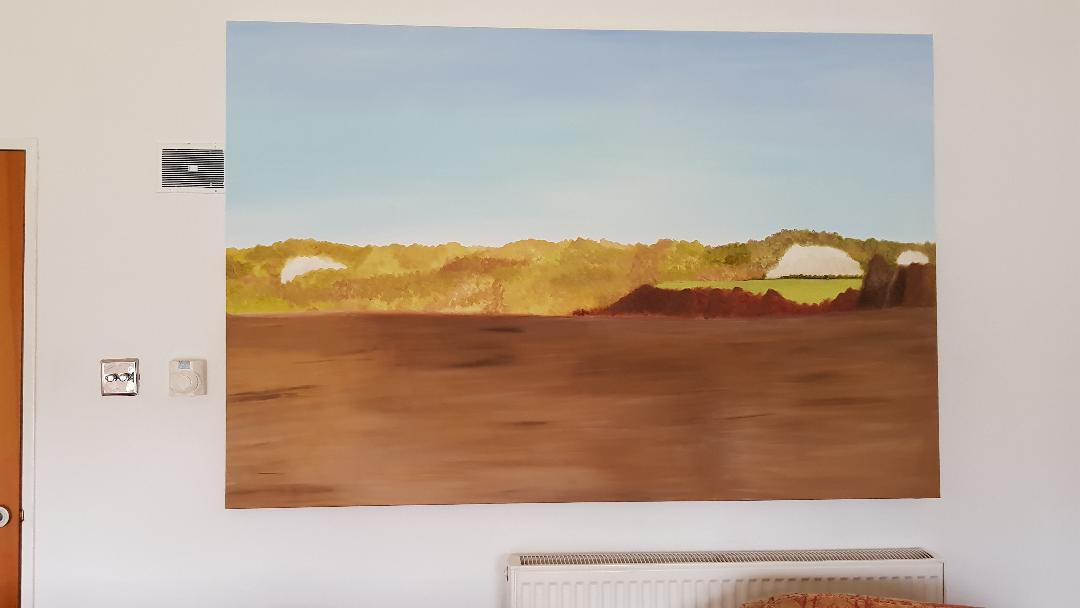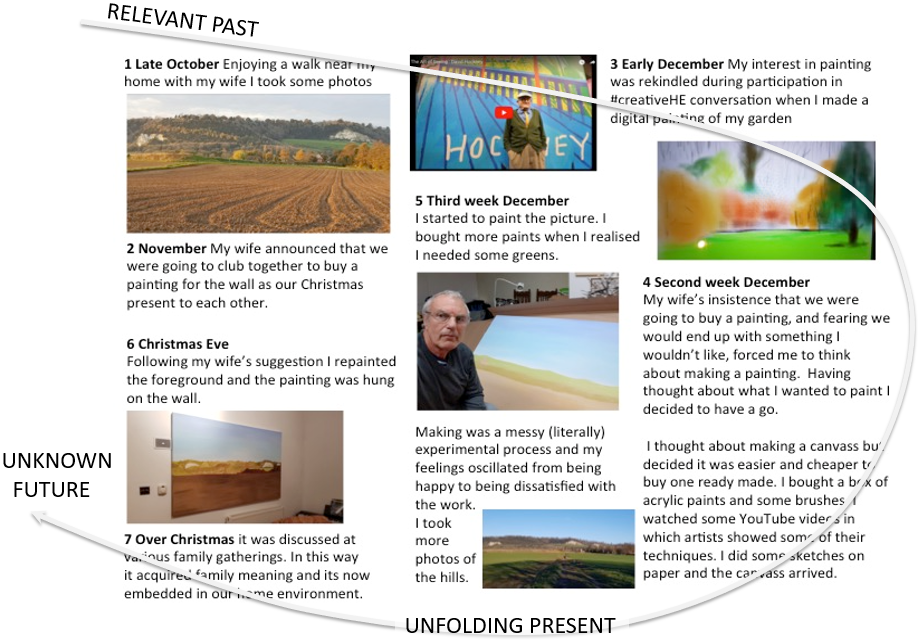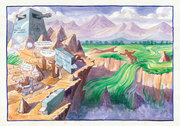Our challenge will be to think of our artefacts less as products of creativity and more as a means for accessing and using creativity. The ‘artistic or aesthetic quality’ of the artefacts we make, will be a secondary consideration and our primary concern will be the process of making and the insights we gain into how our creativity features in the process of making. To provide an illustration I drew on a recent experience I had just one month ago.

In early December 2017 my wife announced that we were going to club together to buy ourselves a painting for Christmas. My first thought was how difficult it was going to be to find something we will both like. My second thought was, I should stop talking about painting something (which I had been doing for years) and actually do it. Another bit of context was that my interest in painting had been rekindled as a result of watching some YouTube videos of artist David Hockney painting and following this I had tried to make a digital painting on my garden.
I went on line and bought a large canvas and stored it in my office as I wanted it to be a surprise. The size of the canvas was determined by an old hot air vent on the wall that we wanted to cover up! But what to paint? I searched for inspiration and remembered a walk we had made in late October when, passing the place where my wife's first husband was buried, we looked back towards the hills behind our house. These hills form a low ridge and there are several chalk quarries in it. I have, through walks with my grandson and a bit of imaginative story telling, renamed this hill, ‘Chalk Mountain’. As we looked across the fields to the hills in the late afternoon autumnal light, we both remarked how stunningly beautiful it was. I took several photographs on my phone. I remembered this moment and phone the photos and decided that this was the scene I wanted to paint it - it inspired me to invest a lot of time, energy, imagination and resources.

Each day that week I spent a couple of hours in my office painting and trying not to arouse suspicion. It’s several decades since I painted anything so I kept it simple and experimented a lot. To make my acrylic paint go further I mixed it with white emulsion paint. A lot of the time I was not happy with the results and the more I painted the more I seemed to get away from what I had hoped to achieve - apart from the sky which was the first thing I painted. I was also worried that my wife wouldn’t like it. But gradually, the composition, colours and effects I wanted, or at least that I could live with, began to emerge and I began to feel a bit happier with the result.
Eventually, on Christmas Eve I plucked up courage to show my wife. She had no idea I was doing it and I was relieved and pleasantly surprised that she didn't tell me to start again. She made a few suggestions, including repainting the foreground and suggested the colour that she thought might work better. I wasn't happy either with the foreground so I readily agreed and sure enough it looked better when it was repainted. I think she was pleased that she had influenced the picture and that evening we hung it on the wall in the lounge.
Hanging it on the wall became a form of public exhibition and a talking point over Christmas when family and visitors were able to comment on it. Because the scene was familiar everyone was able create their own interpretations and meanings. Everyone was surprised and generally complementary and this made me feel good about it. In this way it was accepted and assimilated into our life and our home.
I made a map of the most important events in my project (Figure1). The artefact I made grew out of my relationship with my wife and our interaction with the landscape we live in and to some extent things that had happened in the past. The view of the hills held multiple meanings for me and my wife and these meanings became incorporated, quite naturally into the painting and into the motivations that led to the painting. I did not need to imagine a scene I had seen and experienced this scene and I could see the landscape I wanted to paint any time by taking a 15min walk.

The painting is a novel (for me) relational and meaningful product grown in the particular circumstances of my life. For example, my wife’s insistence that we needed some artwork for the wall and the connection of this to Christmas, were particular contextual circumstances that acted as a catalyst for action. Perhaps also my desire to avoid ending up with a painting I didn’t like was also a factor.
Another recent circumstance was the fact that I had, through my involvement in the early December #creativeHE discussion on creativity in practice, rekindled my interest in painting.
I had watched a number of videos showing artist David Hockney at work which I’d found quite inspiring, and I’d had a go at creating a digital painting of my garden. All these things connected to create the reasons and affordance (opportunity for action) for me to try to paint a picture to fulfil the need I now had.
The form of the artefact itself was influenced by such things as the size of the vent on the wall, my wife’s desires for certain colours (autumnal browns rather than spring of summer greens that I would have preferred), and my need to find a subject that meant something not just to me, but to the whole family, as it was going to become a prominent feature of our home. All these things became connected in my project.
Once I had found my subject I felt motivated to have a go at painting it. I painted the sky and liked it and this encouraged me to go further. But I didn’t like the results of painting the hills and had several goes at it, even changing the shape of the hills and quarries several times. This was my first attempt to pain in many years and I had to do a lot of experimentation mixing colours and using different brushes to get the effects I wanted. It was very much trial and error, or on the job learning, rather than applying techniques that had already been mastered.
Painting the picture was more than an act of self-expression as my wife had to like it as well. If there hadn’t been the Christmas deadline I probably would have carried on tinkering with it for a while. When my wife did finally see it, her positive reaction gave me confidence to see it through (a negative reaction would have caused me to lose heart). I was able to use her suggestion for repainting the foreground and I think that helped her have some ownership for it.
How did my creativity feature in making this artefact? - my theories of creativity
I don’t think any individual part of my making process was creative: in fact putting paint on the canvas felt very uncreative. Through this reflective process I have come to see my creativity as the way I connected everything so that eventually something whole and quite different to anything I had produced before was brought into existence. I found David Gauntlet’s ideas on making particularly useful. At the start of his book ‘Making is Connecting’ he offers three propositions:
Making is connecting because you have to connect things together (materials, ideas, or both) to make something new; Making is connecting because acts of creativity usually involve, at some point, a social dimension and connect us with other people; And making is connecting because through making things and sharing them in the world, we increase our engagement and connection with our social and physical environments. Of course, there will be objections and exceptions to each of these, which we may consider along the way. But that’s my basic set of propositions.’ (Gauntlet 2011:2)
I can see from the map of my process that all three of these propositions are valid. I connected ideas, emotions, experiences and materials in particular ways and in a particular time frame to produce something new and tangible. I connected to people, in particular my wife, who had shared the same experience of the autumn walk that became the inspiration for my painting and also, inadvertently, became the catalyst for my process of connecting. And through the process of making I engaged more deeply with my physical and social environment and the feelings that my interactions created.
Of course, you can’t connect things without perception and imagination (ability to connect things mentally) since seeing that something has the possibility for connection in the first place whether in advance or as the situation presents itself, are important part of this process of making. And, we do not connect random things, there is a process going on all the time where we select and choose things to connect that fit our purpose and our mental models of what we are trying to do. In this way our process of connecting draws together, combines and integrates things that are meaningful in the context of our making. And this process of connecting does not end when we have finished our painting. When we spend time thinking about what we have done by reflecting in a fairly systematic way, our clever mind can see and find even more connections in the process as it tries to make more sense and meaning of the whole perhaps by creating a story. And as I write this now I can see that this story becomes an extension of the making is connecting process.
Of course we can also use technology to assist our imagination. For example, while I was painting I periodically looked at the photograph on my phone to remind myself of the scene and at the same time tap into some nice feelings that helped to motivate me. I was using the technology to connect me back to the moments that triggered my imagination for the project.
But I also had the scene in my mind and I was drawing on the mental image I had which was different to the photo. This imagined image was continuously refined as the colours and shapes went onto the canvas as I used what limited skills I had to try to create a picture that I (and I hoped my wife and family) would be happy with. The final painting was a synthesis of my efforts and perhaps creativity lies in this synthesis of all the efforts.
Making is connecting is a theory of creativity in so far as it explains how and why something is brought into existence. But I would like to emphasis the idea that connecting is an ecological process in which the process of connecting is fundamentally a relational and interactional process of re-making meaning and making new meaning.
My process of ‘making’ was indeed about connecting things but it was also ecological in the sense that in order to connect these things in ways that mattered to me I ‘made’ an ecology that connected many things in ways that were meaningful. So what did my ecology connect?
It involved my purpose, my desire to create this picture in my circumstances and the time frame I had set myself. It involved me physically, cognitively and emotionally, in relationships and interactions with my wife. It involved me interacting with, sensing and experiencing my physical environment - my home and the landscape in which I live, and the virtual environment (accessing videos that inspired me and showed me some techniques) and music I listened to while painting. I connected the resources I needed to like canvas and paints and specialized tools like paint brushes. To make my picture I connected the mental images and emotions to the physical act of painting: I interacted with the paints and canvas to respond to the imagined scenes in my mind. What emerged was not necessarily what I imagined, it was a trial and error process and I stuck with the colours and shapes I liked and repainted what I didn’t like. The very act of painting was creating something that I gave meaning to – what was left meant something to me. I energized myself by playing loud music (often Max Richter’s Three Worlds) as I painted and I know some of this music created certain feelings or moods so that was another connection in the process. And one more way I connected things was to connect to my own past life – for example to my experiences of painting in my youth and a few occasions in adult life.
It seems to me that the process of making of this artefact emerged through the circumstances of my life in the manner envisaged by Carl Rogers (1961) – the creative process is, ‘the emergence in action of a novel relational product growing out of the uniqueness of the individual on the one hand, and the materials, events, or circumstances of their life’. In view of my experience I can personalise and tweak this definition – my creative process involved ‘the emergence, through a process of connecting particular things that mattered to me, of a novel relational product growing out of my uniqueness as an individual on the one hand, and the materials, events, and circumstances of my life’. The map of my making process shows this in action.
The poet and author William Plomer once said, “It is the function of creative people to perceive relations between thoughts, or things, or forms of expressions that seem utterly different, and to be able to Connect the seemingly Unconnected".” But we are all creative people and my story illustrates that when we create we connect, and the things we connect are not really unconnected because they are connected by our very existence in the world we inhabit and interact with. Connections are recognized and forged when we pursue a purpose like the desire to make something or make something happen and we develop (make) an ecology to enable us to achieve this goal.
References
Jackson, N.J. (2016) Exploring Learning Ecologies Lulu
Gauntlet, D. (2011) Making is Connecting, The social meaning of creativity, from DIY and knitting to YouTube and Web 2.0. Cambridge: Polity Press, 2011, 232 pages
Rogers, C.R., (1960) On becoming a person. Boston: Houghton Mifflin







 RSS Feed
RSS Feed